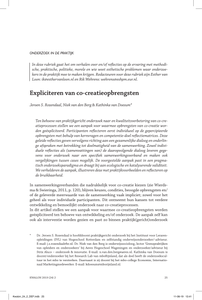Dit document is samengesteld om constructeurs uit de mechatronica industrie met ervaring met metalen een inleiding in ontwerpen met composieten te geven. Het geeft basis info over de belangrijkste verschillen, eigenschappen en voor/nadelen van composieten. Het is niet bedoelt een ontwerphandleiding te schrijven maar een document met basisinformatie en vuistregels.
DOCUMENT

Dit boekje is een methodische handreiking voor onderwijsontwikkelaars, docenten, management, werkveldpartners en studenten om stapsgewijs een competentiegestuurde leeromgeving te ontwerpen.
DOCUMENT

In dit rapport wordt de governance van Nationale parken besproken. Daarna wordt uitleg gegeven over de governance scan en hoe deze toegepast kan worden bij Nationale parken.
DOCUMENT

Ten behoeve van praktijkgericht onderzoek naar en kwaliteitsverbetering van co-creatieprocessen stellen we een aanpak voor waarmee opbrengsten van co-creatie worden geëxpliciteerd. Participanten reflecteren eerst individueel op de gepercipieerde opbrengsten met behulp van kernvragen en competentie-doel reflectiematrices. Deze geleide reflecties geven vervolgens richting aan een gezamenlijke dialoog en onderlinge afspraken met betrekking tot doelmatigheid van de samenwerking. Zowel individuele reflecties als (samenvattingen van) de daaropvolgende dialoog leveren gegevens voor onderzoek naar een specifiek samenwerkingsverband en maken ook vergelijkingen tussen cases mogelijk. De voorgestelde aanpak past in een pragmatisch onderzoeksparadigma en draagt bij aan ecologische en katalyserende validiteit. We verhelderen de aanpak, illustreren deze met praktijkvoorbeelden en reflecteren op de bruikbaarheid.
DOCUMENT

De bedoeling van het Protocol Verbeteren en Verantwoorden van Afstuderen in het hbo is om opleidingen in het hbo te helpen samen werken aan het valide, betrouwbaar en voor studenten inzichtelijk toetsen van de beoogde eindkwalificaties, zoals beoogd in standaard 3/16 van de NVAO en het rapport ‘Vreemde ogen dwingen’ van de Commissie Bruijn (Expertgroep Protocol, 2014). Om dit te bereiken heeft het protocol drie doelen: 1. Duidelijkheid scheppen over terminologie en inrichting van het afstuderen. 2. Een kader scheppen voor gezamenlijk leren en verbeteren. 3. Een kader scheppen voor borging en verantwoording.
LINK
Dit Tech-Info-blad is tot stand gekomen binnen het kader van het kennisoverdrachtproject "Fabricage van producten met geavanceerde productiemiddelen voor het omvormen en verbinden - FPGP". In dit kader zijn ook de volgende publicaties uitgegeven: TI.07.36 - "Laser-MIG/MAG hybride lassen" en TI.07.37 - "Laserlassen van complexe producten". Deze publicatie is bedoeld om bedrijven die overwegen hun buigproces te automatiseren zodanig te ondersteunen dat zij een gelijkwaardige gesprekspartner worden voor de machineleveranciers en daardoor in staat zijn om samen met hen tot de optimale oplossing voor hun buigproces te komen. Meer informatie betreffende het buigen is onder meer te vinden op de websites www.verbinden-online.nl en www.dunneplaat-online.nl, waarop ook de volgende relevante Tech-Info bladen vrij gedownload kunnen worden: TI.00.12 - "Laser- en waterstraalsnijden van gelamineerde en beklede plaat" en TI.07.35 - "Omvormprocessen".
DOCUMENT

Background: The aim of this study is to validate a newly developed nurses' self-efficacy sources inventory. We test the validity of a five-dimensional model of sources of self-efficacy, which we contrast with the traditional four-dimensional model based on Bandura's theoretical concepts. Methods: Confirmatory factor analysis was used in the development of the newly developed self-efficacy measure. Model fit was evaluated based upon commonly recommended goodness-of-fit indices, including the χ2 of the model fit, the Root Mean Square Error of approximation (RMSEA), the Tucker-Lewis Index (TLI), the Standardized Root Mean Square Residual (SRMR), and the Bayesian Information Criterion (BIC). Results: All 22 items of the newly developed five-factor sources of self-efficacy have high factor loadings (range .40-.80). Structural equation modeling showed that a five-factor model is favoured over the four-factor model. Conclusions and implications: Results of this study show that differentiation of the vicarious experience source into a peer- and expert based source reflects better how nursing students develop self-efficacy beliefs. This has implications for clinical learning environments: a better and differentiated use of self-efficacy sources can stimulate the professional development of nursing students.
DOCUMENT

Sommige ggz-aanbieders behalen betere behandeluitkomsten dan andere. We kunnen dus wat van elkaar leren. Transparantie over behandeluitkomsten is daarvoor essentieel. Patiënten die behoefte hebben aan keuze-informatie, zorgverzekeraars die optimale kwaliteit wensen tegen acceptabele kosten en hulpverleners die van elkaar willen leren, hebben daar allemaal baat bij. De auteurs laten zien hoe behandeluitkomsten gebruikt kunnen worden voor het verbeteren van de kwaliteit van zorg in de ggz aan mensen met ernstige psychische aandoeningen. Een belangrijke strategie daarvoor in benchmarken. Maar over benchmarken bestaat veel verwarring. Waarom is benchmarken zo belangrijk? Hoe komt een benchmark tot stand? En hoe kun je een benchmark inzetten voor kwaliteitsverbetering? Nugter, A., Schaefer, B., Swildens, W. (4 april 2017). SBG Conferentie “GGZ Behandeluitkomsten: Bron voor kwaliteitsbeleid in de GGZ. ROM en benchmarken bij patiënten met ernstige psychiatrische aandoeningen. Utrecht, Nederland.
DOCUMENT

Steeds meer ICT-organisaties willen samenwerken, bedrijven om zich heen verzamelen met wie ze kennis kunnen delen, of professionals bijeenbrengen om hun expertise naar een hoger niveau te tillen. Maar hoe doen ze dit effectief en efficiënt? Dit vergt een andere dynamiek in de organisatie, waar het accent komt te liggen op ontdekken en het verbinden van mensen, bijvoorbeeld door middel van crowd sourcing en via social media. Er ontstaat als het ware een ‘Organisatie 2.0’. Het aansturen daarvan vereist een regisseur met vaardigheden op het gebied van verandermanagement, persoonlijk leiderschap en groepsleiderschap om communities te kunnen aansturen.* Wat is social sourcing?* Sociale netwerktheorie als basis voor vinden van verbinding* Leiderschapslessen voor samenwerken in innovatie
DOCUMENT
